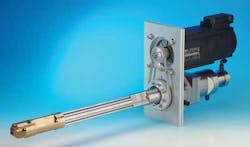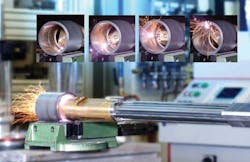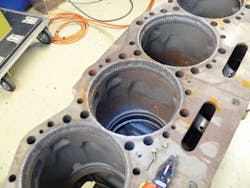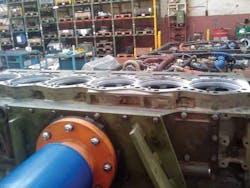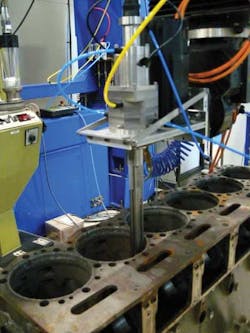Stephan Kalawrytinos, Andreas Weisheit, and Hugues Desmecht
Rotating processing head gives worn-out train engines new lease on life
Laser cladding is a proven technology for repairing or optimizing engine parts because of its reliable reproducibility, marginal thermal component stress and low cost of mechanical reworking to final size, which have made it indispensable. Now, a new device, iClad®, is available for cladding internal contours or blind bores that are inaccessible for conventional heads. This miniaturized processing head is applicable in or for the cladding of aperture diameters down to 26 mm and working depths up to 500 mm. Now, for the first time, its producer, Pallas GmbH & Co. KG (Würselen, Germany), has equipped iClad with a rotating head for repairing worn cylinder bores of a diesel train engine. The rotating version has unparalleled potential for treating internal contours of components with eccentric bores or non-rotationally symmetric openings of 50 mm or more in diameter and with a depth of up to 500 mm.
Repairing large diesel train engines
FIGURE 1. iClad processing head for laser cladding of internal surfaces with rotary drive.
Laser cladding instead of replacements
A replacement engine costs approximately $20,000. In view of the enormous cost and time pressures in the transport sector, laser cladding is an established alternative for greater time- and cost-effectiveness. For sufficiently large access apertures – 100 mm or more – a variety of conventional processing heads are on the market that can process external and internal contours. Now, with the miniaturized rotating iClad head, a reliable repair technique has become available for defective cylinder bores previously inaccessible for standard heads. Thus, the expectations LaserCo DT and the Belgian railway operator placed in the feasibility study by ILT were high.
FIGURE 2. Laser cladding with rotating processing head.
Small processing head — great performance
Each iClad head (FIGURE 1) consists of three modules: powder feed, main body, and fiber plug. In contrast to conventional heads, the working distance between head and component is just a few millimeters. In standard heads, it is up to 20 mm. Depending on the processing point, the laser beam can exit at an angle of either 30° or 90°. Blind bores can easily be coated with a 30° head because the laser’s working point is in front of the head. On through bores, a 90° angle is used. The narrow internal rotating processing head has additional versatility as it can be inserted from the side or from the top into the bore to be coated – down to a depth of 500 mm. The main criterion for industrial applications is the permanent thermal load capacity of the head. Active water cooling prevents overheating of delicate components. An internal protection prevents contamination or destruction of the head through deposits of powder particles. In addition, the optical path is constantly flushed with shielding gas.
FIGURE 3. Diesel locomotive engine block weighing 700 kg.
Rotation inside the bore
A new version of the head (FIGURE 2) with a rotating head was employed for reconditioning the cylinder bores of the diesel engine. The rotary drive integrated into the head allows treatment of eccentric bores of statically mounted components. Even when inserted horizontally, the head ensures uniform powder application independent of its rotation angle. In this specific application, however, the rotating head was inserted vertically into the cylinder bores via a five-axis system. One main argument for using the rotating head was that, because of the sheer weight, it would be impossible to rotate a whole 700-kg diesel engine (FIGURE 3) around a fixed processing head. The eccentric bores would have also created massive imbalance, making it extremely difficult to maintain the required processing precision. Individually centering each cylinder was not a viable option because of the massive cost factor involved.
The aperture diameter of the cylinder bore (FIGURE 4) is 178 mm; the lower area to be coated is situated at a depth of about 340 mm and consists of a ring segment about 60 mm high. Conventional heads can only be applied at an angle in the bores since the nozzles are located at the tip of the processing head. Thus, in spite of an aperture diameter of almost 180 mm, these heads’ use is limited to a depth of approximately 40 mm. In contrast, the rotating iClad head is vertically inserted into the cylinder bore and can process the entire internal surfaces at an angle of 90°. The decisive arguments for the rotating version of iClad were thus threefold: in addition to its rotation capacity and narrow head, the maximum processing depth of 500 mm was also a crucial factor.
Perfect coating with the 5-axis system
The worn cylinder lining at the upper and lower dead points was to be clad with a coating thickness of >1 mm. This called for the cladding of a stainless steel alloy to ensure not only the necessary wear resistance but also good corrosion resistance in acidic and alkaline environments. The toughness of the material, which prevents crack formation, as well as good machining properties and minimum surface porosity of the coating, were additional points in favor of the selected alloy. The worn bores were first machined to a specific dimension at the facility of LaserCo DT’s customer in order to remove all traces of wear and tear and to create a smooth surface for the laser cladding.
FIGURE 4. The aperture diameter is 178 mm for the coating at a depth of 340 mm.
At Fraunhofer ILT, the engine block was placed on a steel support (FIGURE 5), then aligned and adjusted exactly. Dr. Andreas Weisheit and his ILT team, together with Stephan Kalawrytinos from Pallas, then set up the rotating internal processing head (FIGURE 6). Both outside cylinder bores in the lower damaged ring segments were processed. The required coating thickness of 1 mm was achieved by applying two coatings in two overlapping rotational movements of the five-axis system. A CNC program was developed for this purpose. Starting at the bottom edge at a depth of about 300 mm, the coating was applied to the surface in helical form. A 3 kW-Nd:YAG laser was used as the laser source.
Satisfactory conclusion of a groundbreaking test
ILT’s Weisheit is extremely satisfied with the test results. He says, “This proves beyond a doubt that laser cladding in cylinder bores is a technically feasible and cost-effective alternative to the purchase of replacements. The coating applied with the rotating internal contour processing head iClad features excellent surface quality.” In his view, the rotary engine has proven its capability for industrial applications. Even after several hours of continuous use, it continued working absolutely reliably. This complete success offers groundbreaking perspectives for the repair of machine parts previously beyond reach or repair.
FIGURE 5. The iClad head with rotating processing head eliminates the difficult handling of the heavy engine block.
Kalawrytinos sees great potential for the application of the unique head. “The iClad’s five-axis processing capability allows precision reconditioning of worn bores at reasonable costs and in previously unheard-of time frames,” he says.
FIGURE 6. Laser cladding the lower dead center of a cylinder bore.
Stephan Kalawrytinos is managing director of Pallas GmbH & Co. KG (Würselen, Germany), Dr. Andreas Weisheit is with Fraunhofer ILT (Aachen, Germany), and Ir. Hugues Desmecht is managing director of LaserCo DT (Strépy-Bracquegnies, Belgium). For more information, email: [email protected] or [email protected]
Past ILS Issues
